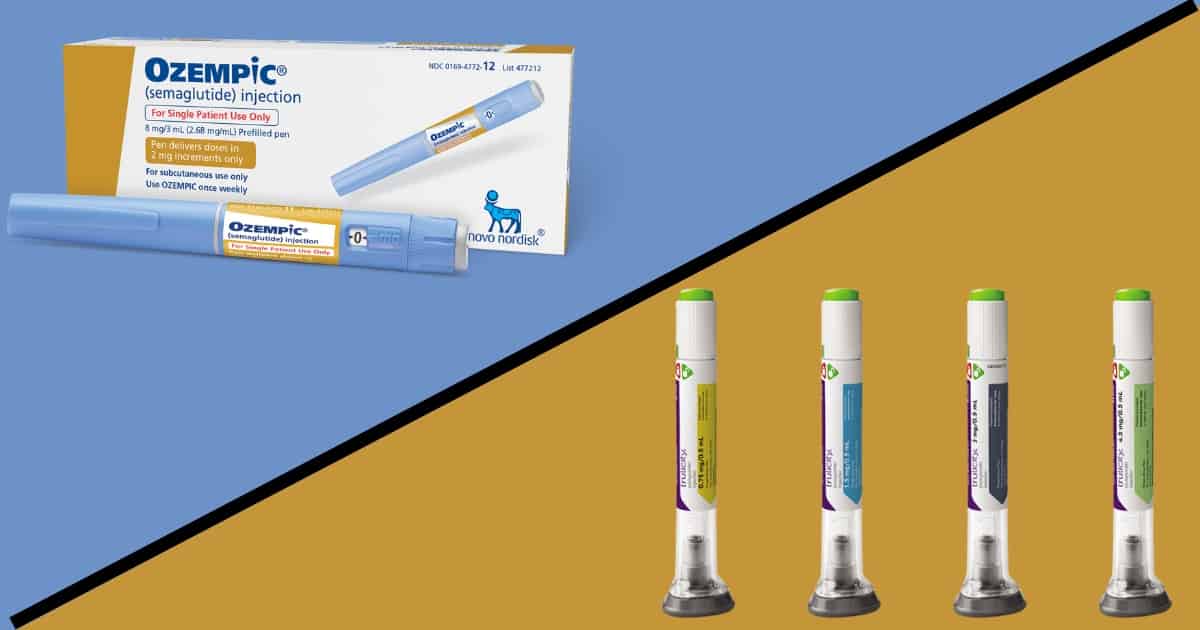Trulicity and Ozempic are both once-weekly GLP-1 agonist injections used to lower blood sugar levels in people with type 2 diabetes.
This article will explore the key similarities and differences to help you determine which medication might be right for you.

Key Points:
- Trulicity contains dulaglutide, while Ozempic contains semaglutide.
- The medications have different active ingredients but similar side effects.
- Ozempic may be more effective than Trulicity in improving blood sugar management and reducing body weight.
- They should not be taken together and require careful consideration of health needs and insurance coverage.
What are Trulicity and Ozempic?
Trulicity and Ozempic are name-brand injectable drugs classified as GLP-1 agonists. Both are approved by the U.S. Food and Drug Administration (FDA) to manage blood sugar levels in people with type 2 diabetes.
Trulicity is approved for children ages 10 and up and adults, while Ozempic is approved for adults only.
Both medications can also help with weight loss and help prevent stroke, heart attack, and premature death in those with type 2 diabetes and preexisting heart disease.
Read more in: Everything You Need to Know About Trulicity and Everything You Need to Know About Ozempic.
Why would you take Trulicity or Ozempic?
You may be prescribed one of these medicines if you have type 2 diabetes, particularly if you are dealing with insulin resistance, persistent high blood sugar (especially after meals), and difficulty maintaining a healthy weight.
Studies indicate that GLP-1 agonists like Ozempic and Trulicity can promote weight loss, although neither is FDA-approved for this purpose.
If prescribed off-label (in a manner not officially approved by the FDA), these medications may also be used to improve insulin sensitivity and help with weight loss, even in those without type 2 diabetes. Always take them under a doctor’s guidance.
See more in: Everything You Need to Know About Trulicity and Everything You Need to Know About Ozempic.
How are Trulicity and Ozempic similar?
Trulicity and Ozempic share several similarities:
They do not replace insulin
These medications do not replace insulin but can supplement it in managing blood sugar levels over time.
They help lower blood sugar gradually without causing acute hypoglycemia (low blood sugar).
As insulin resistance decreases, you may require less insulin to manage your blood sugar levels.
They are injectable medications, taken once a week
Both are available only as subcutaneous (under the skin) injections, taken once a week.
It’s important to maintain consistency by administering the treatment on the same day and at the same time each week.
They have similar side effects
Trulicity and Ozempic share many side effects, which may include:
- Nausea
- Vomiting
- Diarrhea
- Stomachache
- Suppressed appetite
- Weight loss
- Constipation
- Fatigue
- Low blood sugar (if used with insulin)
Both medications, though rarely, can increase the risk of developing medullary thyroid carcinoma (MTC). If you have a personal or family history of MTC, you should avoid these medications.
Additionally, the FDA has issued a black box warning for both drugs regarding their association with an increased risk of thyroid cancer.
Read more in: Trulicity Side Effects: What You Need to Know and Ozempic Side Effects: What You Need to Know.
They cause weight loss and lower blood sugar levels
Both Trulicity and Ozempic effectively lower blood sugar levels and promote weight loss.
Although not FDA-approved specifically for weight loss, many people experience a reduction of more than 5 percent of their body weight while taking these medications.
Since they are not approved for weight loss, there is no recommended dosage specifically for that purpose.
If you’re considering options for managing your weight, Trulicity or Ozempic might be suitable choices to discuss with your healthcare provider.
Read more in: Trulicity and Weight Loss: Can Trulicity Help You Lose Weight? and Can Ozempic Help You Lose Weight?
They can be taken with or without food
The medicines can be taken with or without food, unlike insulin, which can cause sudden drops in blood sugar.
The best time to take your dose is when you’re most likely to remember it each week.
See more in: Trulicity Dosing: How Much Should You Take? and Ozempic Dosage Guide: How Much Should You Take?
While not required, having a small snack before or after your injection may help alleviate nausea.
Opt for bland foods like bananas, rice, toast, applesauce, or clear-broth soups. Diet plays a crucial role when adjusting to a new medication, so be mindful of the foods you choose.
See more in: Foods to Avoid When Taking Trulicity and Foods to Avoid While Taking Ozempic.
How are Trulicity and Ozempic different?
Although similar, the medications have key differences.
Their active ingredients are different
Although Trulicity and Ozempic are both GLP-1 agonists, they differ in their active ingredients. Trulicity contains dulaglutide, while Ozempic contains semaglutide.
If you are allergic to either of these ingredients, consult your doctor before starting treatment, as you could experience severe side effects.
Ozempic may be more effective
In a pivotal study comparing semaglutide (Ozempic) and dulaglutide (Trulicity) in people with type 2 diabetes, semaglutide was found to be more effective at improving blood sugar management and reducing body weight at both high and low doses, with a similar safety profile.
If you’re dealing with severe insulin resistance and difficulty maintaining a healthy weight, consider discussing Ozempic with your doctor to see if it might be a good fit for you.
Frequently asked questions
Can I switch between the two?
Yes, it is possible to switch between Trulicity and Ozempic.
However, your healthcare provider will likely recommend waiting a week after your last dose of one before starting the other to minimize the risk of severe side effects.
If you’re allergic to either of their active ingredients — semaglutide in Ozempic or dulaglutide in Trulicity — you should not switch between them.
If you’re experiencing significant side effects with one, trying the other might be a better option, as your body may tolerate it differently.
Can I take both at the same time?
No, you cannot take Trulicity and Ozempic together, even though they have different active ingredients.
Double-dosing GLP-1 agonists can lead to severe side effects, including dangerously low blood sugar, which could be life-threatening if not treated.
If you accidentally take both medications at the same time or within a 2-day period, call your doctor immediately or seek emergency medical attention.
Which medication is right for me?
Choosing between Trulicity and Ozempic is a decision that you and your healthcare provider should make together, based on your health history, goals, lifestyle, and preferences.
Always consider the active ingredients and any potential allergies. Additionally, check your health insurance coverage to see which medications are on the preferred drug list, ensuring you select an affordable, long-term option.
While there are no generic versions of Trulicity or Ozempic, your doctor may suggest more affordable alternatives.
Learn more in Everything You Need to Know About Trulicity and Everything You Need to Know About Ozempic. Did you find this article helpful? Click Yes or No below to let us know!





